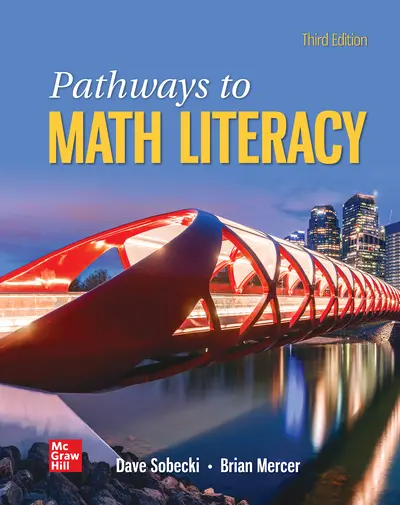My Account Details

ISBN10: 1266579133 | ISBN13: 9781266579134

* The estimated amount of time this product will be on the market is based on a number of factors, including faculty input to instructional design and the prior revision cycle and updates to academic research-which typically results in a revision cycle ranging from every two to four years for this product. Pricing subject to change at any time.
Instructor Information
Quick Actions (Only for Validated Instructor Accounts):
Pathways to Math Literacy is known for putting developmental math in a real-world context, fostering critical thinking and showing students why math is relevant to their lives. The new third edition is no exception. The text is strengthened by its offering in ALEKS, now featuring Custom Question Authoring, Video Assignments, interactive tools, and more!
ALEKS is a course assistant that helps math instructors forge Constructive Learning Paths for their students – blending personalized modules with instructor-driven assignments to ensure every student always has another block to build on their knowledge base.
Lesson 1-1 Where Does the Time Go? (Percentages, Pie Charts, and Bar Graphs)
Lesson 1-2 Do You Have Anything To Add? (Using Addition and Subtraction Skills)
Lesson 1-3 It’s About Accumulation (Using Multiplication and Division Skills)
Lesson 1-4 Avoiding an Empty Wallet (Using Exponents and Order of Operations)
Lesson 1-5 A Coordinated Effort (The Basics of Graphing)
Lesson 1-6 What are the Chances? (Basic Probability)
Lesson 1-7 Debt: Bad. Chocolate: Good (Using Scientific Notation)
Lesson 1-8 What’s Your Type? (Organizing Information with Venn Diagrams)
Lesson 1-9 News in the Data Age (Gathering and Organizing Data)
Unit 2: MAKING SENSE OF IT ALL
Lesson 2-1 Did You Pass the Test? (Using Measures of Average)
Lesson 2-2 Ins and Outs (Inputs, Outputs, and Interpreting Expressions)
Lesson 2-3 From Another Dimension (Working with Units and Formulas)
Lesson 2-4 It Works Like Magic (Dimensional Analysis)
Lesson 2-5 It’s All Relative (Interpreting Relative Change/Relative Error)
Lesson 2-6 Is that Normal? (Standard Deviation and Normal Distributions)
Lesson 2-7 Meeting Expectations (Expected Value and Weighted Grades)
Unit 3: THINKING LINEARLY
Lesson 3-1 Miles Per Hour! (Slope as a Rate of Change)
Lesson 3-2 All Things Being Equal (Solving Equations)
Lesson 3-3 All Quantities Are Not Created Equal (Solving Inequalities)
Lesson 3-4 What’s Your Problem? (Solving Problems Numerically and Algebraically)
Lesson 3-5 Big Mac Exchange Rates (Direct Variation and Proportions)
Lesson 3-6 The Effects of Alcohol (Slope-Intercept Form and Linear Modeling)
Lesson 3-7 Party Planning (Point-Slope Form and Linear Modeling)
Lesson 3-8 The Great Tech Battle (Linear Relationships and Lines of Best Fit)
Lesson 3-9 All Systems Go (Solving Problems with Systems of Equations)
Unit 4: LIVING IN A NONLINEAR WORLD
Lesson 4-1 Oh Yeah? Prove It! (Inductive and Deductive Reasoning)
Lesson 4-2 A Road Map to Success (The Pythagorean Theorem and Distance)
Lesson 4-3 The Error of Your Ways (Polling and Margin of Error)
Lesson 4-4 Where’s My Jetpack? (Inverse vs. Direct Variation)
Lesson 4-5 Sit Back and Watch Your Money Grow (Exponential Growth Equations)
Lesson 4-6 Follow the Bouncing Golf Ball (Exponential Curve Fitting)
Lesson 4-7 Irate Ducks (Graphs of Quadratic Equations)
Lesson 4-8 Minding Your Business (Add, Subtract, and Multiply Expressions)
Lesson 4-9 The F Word (Factoring)
Lesson 4-10Going. . . Going. . . GONE! (The Quadratic Formula and Max/Min)
Lesson 4-11 Down the Drain (Quadratic Curve Fitting)
Accessibility
Creating accessible products is a priority for McGraw Hill. We make accessibility and adhering to WCAG AA guidelines a part of our day-to-day development efforts and product roadmaps.
For more information, visit our accessibility page, or contact us at accessibility@mheducation.com
Need support? We're here to help - Get real-world support and resources every step of the way.